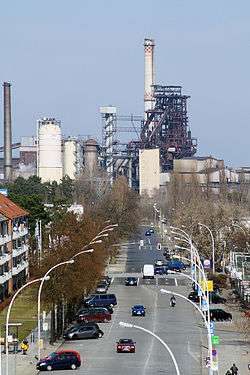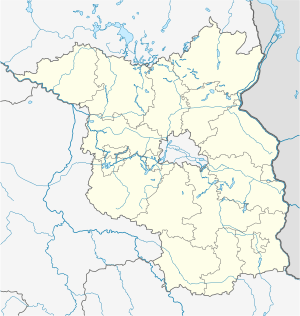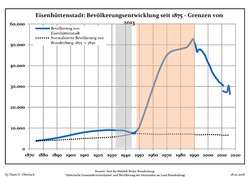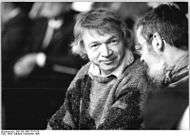Eisenhüttenstadt
Eisenhüttenstadt (literally "ironworks city" in German; [ʔaɪzn̩ˈhʏtn̩ʃtat] (![]()
Eisenhüttenstadt | |
|---|---|
 View over Eisenhüttenstadt | |
 Coat of arms | |
Location of Eisenhüttenstadt within Oder-Spree district  | |
 Eisenhüttenstadt  Eisenhüttenstadt | |
| Coordinates: 52°08′42″N 14°40′22″E | |
| Country | Germany |
| State | Brandenburg |
| District | Oder-Spree |
| Subdivisions | 4 districts |
| Government | |
| • Mayor | Frank Balzer (SPD) |
| Area | |
| • Total | 63.40 km2 (24.48 sq mi) |
| Elevation | 42 m (138 ft) |
| Population (2018-12-31)[1] | |
| • Total | 24,633 |
| • Density | 390/km2 (1,000/sq mi) |
| Time zone | CET/CEST (UTC+1/+2) |
| Postal codes | 15890 |
| Dialling codes | 03364 |
| Vehicle registration | LOS |
| Website | www.eisenhuettenstadt.de |
Geography
The municipal area stretches on a sandy terrace in the Berlin-Warsaw glacial valley (Urstromtal). It is bounded by the Oder river in the east, which since 1945 has formed the German–Polish border. Eisenhüttenstadt is the eastern terminus of the Oder–Spree Canal. The town centre is located about 25 kilometres (16 mi) south of Frankfurt (Oder) and 110 km (68 mi) southeast of Berlin. Eisenhüttenstadt has access to the Berlin–Wrocław railway line.
The town comprises the districts of Diehlo, Fürstenberg (Oder), and Schönfließ.[2]
History
The present-day town was founded as a socialist model city in 1950 (initially named Stalinstadt after Joseph Stalin) following a decision by the East German Socialist Unity Party (SED), alongside a new steel mill combine located west of the historic town of Fürstenberg (Oder).[3] A few years before the new town was established, a bridge over the Oder river had been constructed, the earlier one having been destroyed by retreating Wehrmacht forces in February 1945, near the end of World War II.
The population grew rapidly in the 1950s and 1960s. In 1961, during de-Stalinization, the town was renamed Eisenhüttenstadt. After German reunification in 1990, the state-owned steel works were privatized, and most of its 12,000 employees lost their jobs. Thereafter the factory employed around 2,500 workers.[4] The town experienced a steep decline in population, from just over 50,000 to under 30,000.
Demography
 Development of Population since 1875 within the Current Boundaries (Blue Line: Population; Dotted Line: Comparison to Population Development of Brandenburg state; Grey Background: Time of Nazi rule; Red Background: Time of Communist rule)
Development of Population since 1875 within the Current Boundaries (Blue Line: Population; Dotted Line: Comparison to Population Development of Brandenburg state; Grey Background: Time of Nazi rule; Red Background: Time of Communist rule) Recent Population Development and Projections (Population Development before Census 2011 (blue line); Recent Population Development according to the Census in Germany in 2011 (blue bordered line); Official projections for 2005-2030 (yellow line); for 2014-2030 (red line); for 2017-2030 (scarlet line)
Recent Population Development and Projections (Population Development before Census 2011 (blue line); Recent Population Development according to the Census in Germany in 2011 (blue bordered line); Official projections for 2005-2030 (yellow line); for 2014-2030 (red line); for 2017-2030 (scarlet line)
|
|
|


Architecture
The first design for the new residential quarter was developed by the modernist and Bauhaus architect, Franz Ehrlich, in August 1950. His modernist plan, which laid out a dispersed town landscape along functional lines, was rejected by the Ministry for Reconstruction. The same happened to the plan presented by the architects Kurt Junghanns and Otto Geiler. The plan that was ultimately realized was developed by Kurt Walter Leucht.[6][7]
International relations
Eisenhüttenstadt is twinned with:[8]




Notable people
Eisenhüttenstadt was the birthplace of:
- Bernhard Lösener (1890–1952), jurist
- Udo Beyer (born 1955), shot put, Olympian champion 1976 and holder of world record
- Hans-Georg Beyer (born 1956), handball player, olympic winner 1980
- Detlef Gerstenberg (1957–1993), hammer thrower, competitor in 1980 Summer Olympics
- Frank Schaffer (born 1958), athlete, medal winner in 1980 Summer Olympics
- Katharina Bullin (born 1959), volleyball player
- Gisela Beyer (born 1960), athlete
- Hendrik Reiher (born 1962), rowing cox, medal winner in multiple Olympic Games
- Torsten René Gutsche (born 1968), sprint canoer, competitor in two Summer Olympic Games; 1992 winner of the Bambi Award
- Sven Helbig (born 1968), producer, musician
- Kathrin Boron (born 1969), sculler, competitor in multiple Olympic Games, gold medalist in several World Rowing Championships
- Sören Lausberg (born 1969), retired track cyclist, competitor in two Summer Olympic Games
- Paul van Dyk (born 1971), DJ, composer and music producer
- Amadeus Wallschläger (born 1985), footballer
- Roger Kluge (born 1986), racing cyclist, silver medal winner in 2008 Summer Olympics
- Florian Müller (born 1986), footballer
Other personalities associated with the city

- Rudolf Bahro (1935–1997), regime critic and author of the book The alternative. A critique of real-existing socialism., spent his school days in the city
- Tamara Bunke (1937–1967), fellow combatant of Che Guevara in Bolivia, took her Abitur (school leaving examination) in Eisenhüttenstadt
- Rolf Henrich (born 1944), lawyer, first signatory of the Founding Congress of the New Forum
- Tom Hanks visited the city in 2011, creating much free publicity for the city.[9][10]
References
- "Bevölkerung im Land Brandenburg nach amtsfreien Gemeinden, Ämtern und Gemeinden 31. Dezember 2018". Amt für Statistik Berlin-Brandenburg (in German). July 2019.
- "Stadt Eisenhüttenstadt". Land Brandenburg (in German).
- "Eisenhüttenstadt". Eisenhuettenstadt (in German).
- Emily Young (28 April 2014). "Germany: The rise and fall of a model socialist city". BBC News. Retrieved 28 April 2014.
- Detailed data sources are to be found in the Wikimedia Commons.Population Projection Brandenburg at Wikimedia Commons
- "BernhFalter.pmd" (PDF). Archived from the original (PDF) on 2007-06-30. Retrieved 2007-06-04.
- "Archived copy". Archived from the original on 2007-09-27. Retrieved 2009-08-06.CS1 maint: archived copy as title (link)
- "Unsere Partnerstädte". eisenhuettenstadt.de (in German). Eisenhüttenstadt. Retrieved 2019-11-30.
- "Eisenhüttenstadt: Tom Hanks' kind of place". Deutsche Welle. 31 July 2012.
- https://www.youtube.com/watch?v=B3h2Rw1mHew
External links
| Wikimedia Commons has media related to Eisenhüttenstadt. |